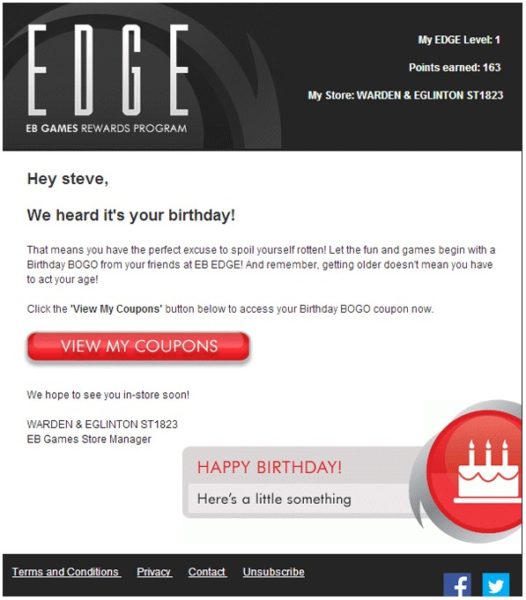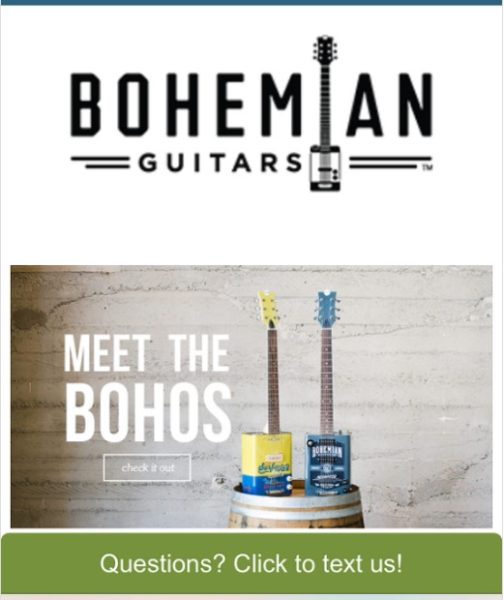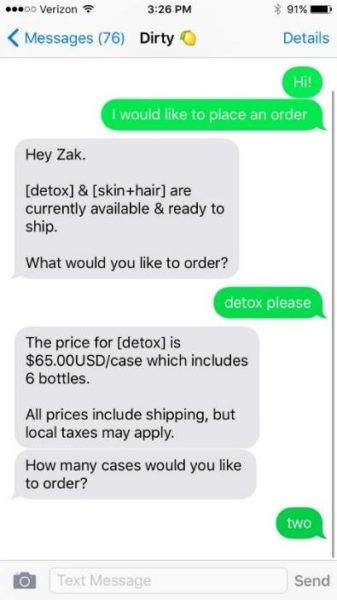It is estimated that over 8,600 brick-and-mortar stores will have closed their doors in 2017. These dismaying numbers surpass 2008, the worst year on record for retail, when 6,163 stores turned off their lights for good.
Retailers are clearly struggling to compete with giants like Amazon who are gobbling up industries at a voracious pace.
Don’t panic, differentiate!
Today, more than ever, companies need to think about how they can differentiate their shopping experiences in new and innovative ways to increase sales and more importantly, gain loyalty.
In the last 10 years, Amazon has grown by almost 2000%, while other top retailers have seen decline of up to 96%.
Amazon has proven to be one of the most innovative companies in the world. This is because they are not afraid to experiment with technology to differentiate their customer experience.
There are many ways to stand out from the crowded retail space, but as you will see later, along with other factors, text messaging plays an important role in creating better relationships with customers.
When I talk about differentiation, I’m not talking about lowering prices to compete. In fact, that should never be the solution. The reality is that you may never have the lowest price in the market and lowering prices just hurts your overall bottom line.
A customer service study conducted by Prosperinsights.com, revealed 10 keywords shoppers used to describe why they prefer one retailer over another (in order of frequency).
- Helpful
-
Returns
-
Easy
-
Quick
-
Problems
- Shipping
- Friendly
- Price
- Knowledgeable
- Selection
As you can see, price does not even make the top five. What’s interesting about this data is that it shows that customers care a lot more about a better service and experience than the price of the product itself.
This information is extremely valuable for retailers as they focus their attention on providing a better overall experience throughout the entire customer journey. And it doesn’t stop after the purchase.
Your next question may be “how can I differentiate my customer experience?” Great question.
There are many different strategies that retailers are experimenting with to differentiate their shopping experience that do not include lowering prices. Here are some examples to get your creative juices flowing.
Be Omnichannel – This has been a buzzword for quite some time now, but more and more retailers are increasing the number of channels customers can purchase from. More importantly, it’s about connecting the channels to create a seamless experience across channels and devices.
Crate & Barrel is a classic example of how omnichannel retail works. If a shopper starts the shopping process on a desktop, then switches to tablet, then to a smartphone, all previous browsing history and carted items are carried over so the experience is consistent across devices.
Starbucks is another great example of omnichannel as they allow customers to check and load rewards cards as well as pay directly through the mobile app. No wallet, no problem.
Personalize Experiences – Consumers want to feel special. According to Forrester research, 77% of consumers have chosen, recommended, or paid for a brand that provides a personalized service or experience. Personalization is all about leveraging your customer data to provide a more relevant shopping experience for your customers.
The most common uses of personalization include product recommendations, targeted promotions and customer service based on each customer’s online shopping activities, transactions, preferences and even leveraging social media data to personalize experiences.
EB Games, a video game retailer has a nice example of delighting a customer with a timely and personalized email. Although commonly used, leveraging customer birthdays is a great way to surprise customers with a birthday note and a coupon to purchase. A perfect example of personalized retargeting.
Communicate via Text Messaging – So what does customer experience have to do with text messaging? Everything!
In the customer service study referenced above, the top five keywords related to the retail experience were Helpful, Returns, Quick, Easy and Problems. Can you identify the common theme? Communication.
Even though phone calls, emails, live chat and even social media are great customer communication channels, there is one major channel missing: Text messaging.
Text messaging plays an important role in both omnichannel and personalization for retail businesses
First, when it comes to omnichannel, it’s all about being available wherever your customers are. With one in five consumers likely to prefer a text message instead of a phone call, it’s essential for businesses to enable texting to expand their customer reach.
Personalization provides the most relevant and individualized customer experiences across all channels, and text messaging enables retailers to leverage real-time behavioral and historical data to send the most relevant messages at the right time to today’s mobile-first consumer.
How can retailers differentiate themselves and provide a better customer experience through text messaging?
I’d like to think of text messaging as the new email, but with better results. For a quick comparison, the average open rate for emails is 20%, whereas text message open rates are up to 98%!
Many retailers use text messaging for:
- Customer service
- Account management
- Shipping/delivery notifications
- Marketing Campaigns
- Customer satisfaction surveys
Here are some examples of how actual retailers are using text messaging:
Bohemian Guitars – Customer Service
This guitar retailer noticed that a lot of sales were coming from mobile devices, so they added a banner that allowed customers to text in questions as they are browsing on the mobile site.
According to owner Shawn Lee, texting with customers resulted in an increase of about 98% in sales in less than 6 months. He gives credit to the quickness and personal connection that texting provides to help customers buy the right guitar while they are still on the website.
Redbox – New Release Alerts
This popular DVD and game rental service offers “Red Text Club”, which sends text message alerts to customers whenever there is a new release or promotion. This remarketing strategy puts Redbox in a great position to re-engage customers who may not have rented from them in a while and get them to come back.
Julep – Text Promotions
This online-based beauty products retailer sent text message coupons to their customers for their new nail polish and saw a 34.23% click through rate and converted 17.44% of those customers.
Dirty Lemon – Text to Order
This online-based health beverage company made texting their entire business model. With numerous competitors in their space, Dirty Lemon decided to only allow text message orders to differentiate in the market. Like a normal eCommerce retailer, shoppers can browse products and create an account on their website. But instead of a traditional online checkout, they only take orders through text message. Only one year into the market, Dirty Lemon shipped more than 10,000 orders and sees a 20% re-order rate.
As you can see from these examples, there are many ways retailers can benefit from texting with customers. But it’s not simply a matter of sending a text as you would to a friend. To be successful, you need to have a plan and goal in mind before jumping in.
Here are some things to consider when planning your texting program:
- Plan your text communication strategy and set goals based on how you will be using text messaging to communicate with customers.
- Select the right SMS software to support text communications and better manage messages across departments and platforms (Integrations: CRM, PMS, Facebook Messenger, Twitter, Line, WeChat…).
- Launch your text program to your customers by promoting your text number everywhere your customers can see your brand.
- Track performance that aligns with your goals to ensure you are meeting specific business objectives like increasing customer satisfaction, improving operational efficiency or driving more revenue.
The Bottom Line
Differentiating your customer experience is crucial to competing with not just Amazon, but the millions of other retailers that are trying to steal your customers. If you don’t do something unique, your competitors will. When you combine omnichannel, personalization and text messaging, the possibilities are limitless as to how you can differentiate your brand and create more happy and loyal customers.




